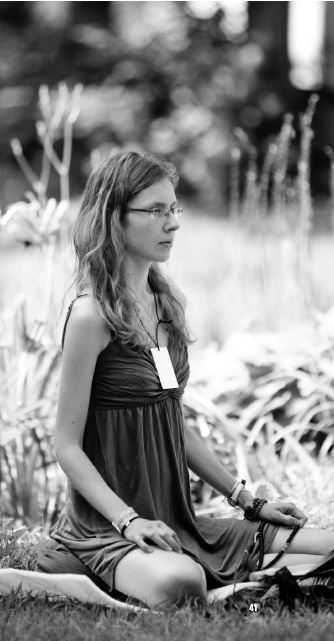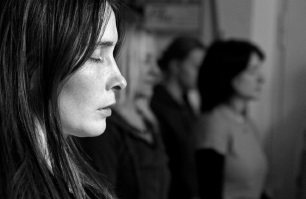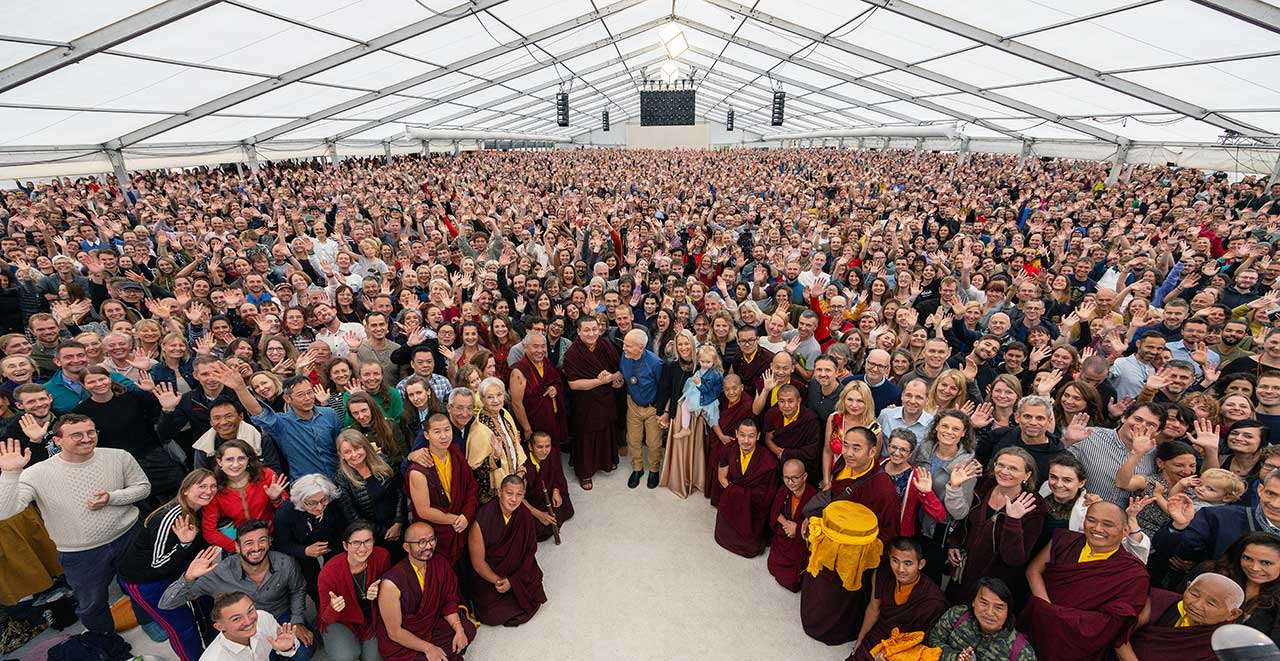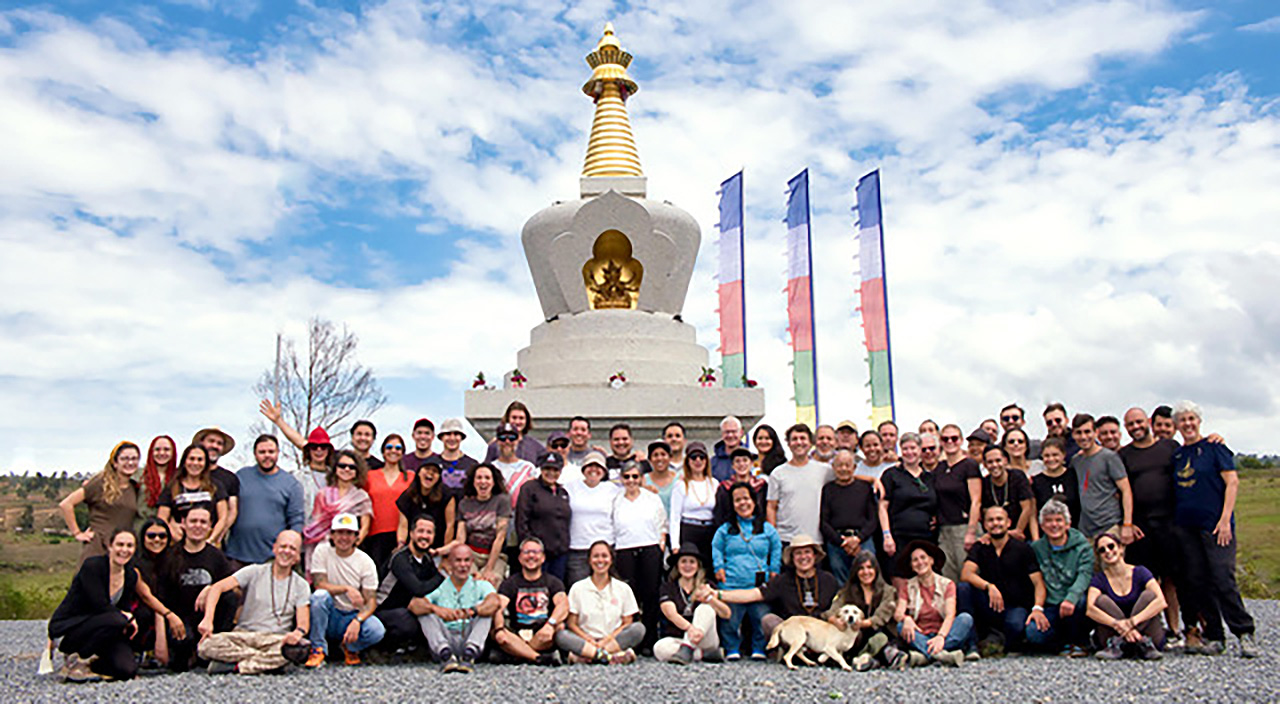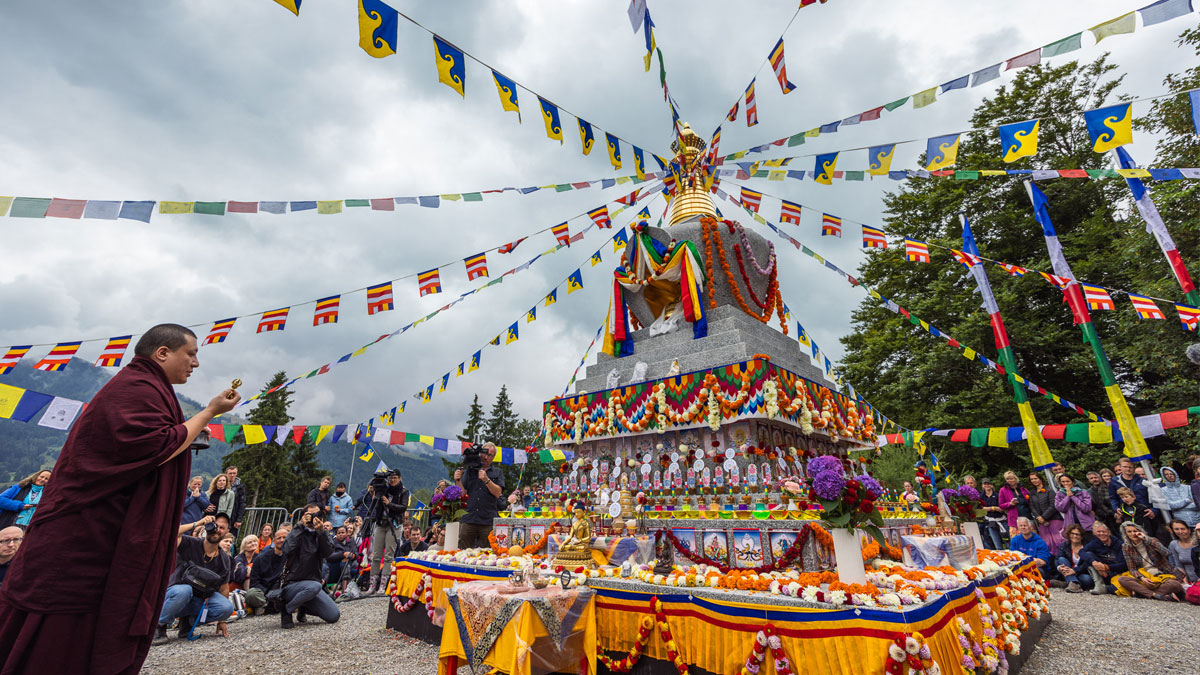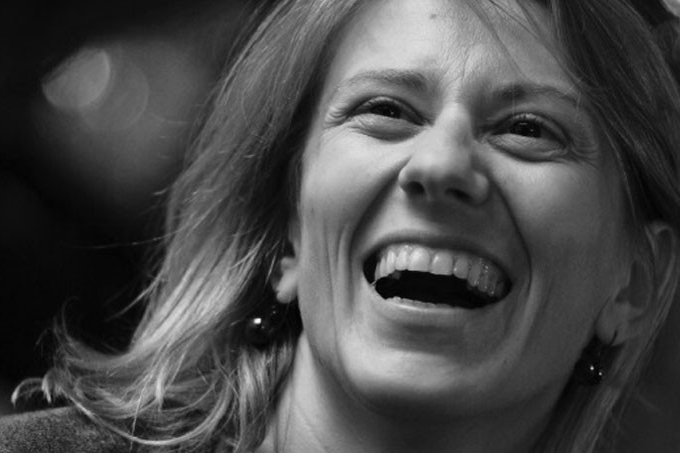
Edited by Tünde Zilahy
Editor’s Note: The text that follows is an edited compilation of interviews that took place in June 2012 at the Europe Center at the International Traveling Teachers meeting.
Many strong and inspiring women practice Diamond Way Buddhism and they motivate both Buddhists and non-Buddhists alike with their wisdom, compassion, and understanding of the dharma. One of our greatest examples was and still is Hannah Nydahl. Her enormous and tireless work at the side of Lama Ole Nydahl gives inspiration even to those who never met her. Their united activity enables us today to use Buddha’s highest teachings in our Western societies. Hannah and Ole were a couple whose idealism and endurance showed not only that we have the potential to reach whatever we aim for, but also how men and women complete each other on different levels. Although male and female principles are inseparable, we will now look at the female aspect in a bit more detail with the help of our female lay Buddhist teachers from around the world. May this article inspire both women and men on the way, Buddhist and non-Buddhist, to unfold their inherent qualities.
Let’s start at the beginning. We are a Tibetan Buddhist lineage, and these teachings have been available here in the West only for the last forty years. Could you tell us something about the cultural background in Tibet? It appears that women and men weren’t that equal.
Maria: If you have a look at Tibet, their traditional culture was patriarchal. However, this didn’t mean that the women had no power. They had a very strong position at home, especially if they were married and had kids. But when it came to religion, it was a totally different story. Here women were associated with everyday life, which many people were trying to renounce by becoming monks or nuns. Therefore, lay women were seen as reminders of samsara, so this is the reason they weren’t generally highly valued. However, this view of females has nothing to do with Buddhism as such, but depends on the culture. Now, it is true that we learned Buddhism from Tibetans, but still we should learn the essence of the methods that lead to the recognition of the nature of mind, and not their cultural packaging. In this case it means that we Westerners don’t need this limited view that women can only be valuable to society as mothers or housewives. We should try to filter out the unnecessary cultural concepts and focus on the core teachings.
What is left if we filter out the Tibetan cultural background? What is the Buddhist attitude to men and women?
Michaela: According to Buddha’s teachings, all beings have buddha nature, the potential to reach enlightenment. Women and men certainly have different qualities, but the goal is to bring them together to go beyond duality. It is important for both men and women to appreciate the other sex and see their qualities. We open up to each other, develop, and learn from each other. In Buddhism we have the same value and we are allowed to be different at the same time. Neither is better nor worse. While men open up to the female wisdom and space, we women are inspired by men’s joy and activity. In this way we can complete each other without any competition.
Maria: We have the best possible example in Lama Ole and Hannah, a couple who were complete partners and equal in their training, completing each other in their qualities. They were both empowered by the 16th Karmapa as his main Western students, then they went out into the world and started centers together. In this way, they also gave us a very good example of how to transmit this traditional structure of Buddhism so that it is still convincing in our modern, egalitarian culture.
What are the advantages and disadvantages of being a female Buddhist practitioner?
Karola: I have heard people say it is an advantage to be a woman if your teacher is a man. Personally, I have not perceived my root-teacher as a man too much, but rather was deeply impressed by his convincing personality. In this sense a male practitioner can also fall in love with a male teacher and vice versa. I like being a woman. I enjoy living in a society that gives me choices in how I live, work, and express myself, and I wish that we will keep this freedom. In our Diamond Way centers, probably in contrast to life in Asia, gender does not make a difference in the ability to obtain an influential position. Instead, it is the life experience and meditation that counts.
What are the different qualities of female and male?
Karola: Women have more space, but often tend to hold onto too much. Men are very playful and do not need to relate to somebody as strongly as women do. Women often suffer from low self-esteem, which is the result of pride, ignorance and quite a bit of laziness. So inclusive pride about womanhood with its rich facets of harmonizing, healing, holding, and loving, yet still being wild and having powerful qualities, would help. The strong emotions of a woman are nothing other than wisdoms, and to be afraid of them is ignorance. For men it is important to learn that they are not losing anything by being committed, as playful activity is unlimited by nature.
Karolina: A woman has a rounded perspective. She knows what is going on around her. The space around her is like her own body, while men have a tunnel-like perspective. For him, space is more like a playground of possibilities where he likes to express himself. Women like to have a certain kind of harmony and safety. Maybe that is why we sometimes have the tendency to control our surroundings. Therefore, we should learn to let things unfold in their own time and place without holding or controlling them. This gives space for development. Usually, women work in the background. We do work that is not so visible but which offers possibilities for others. Housework is not so visible; nobody praises you for it. You are constantly working, but nothing is seen. Living like this, women have a better chance to see impermanence and the illusory nature of things. Everything is subject to change. In this way, women are closer to the point, because change itself points out the empty nature of all phenomena.
Michaela: Instead of looking at each other expecting the other one to make us happy, it is much more meaningful to practice a rich kind of love—wishing the other one total happiness, looking in the same direction toward happiness, and shining on others. To be able to do that, it is essential to take responsibility for one’s own state of mind. Take refuge in the qualities of mind and not in the partner, and practice meditation. Karola: When I was writing Yeshe Tsogyal’s biography, what really touched me was to see from her example that a relationship is not a refuge but a big part of your development. Every one of her companions deepened her possibilities to be beneficial for others by helping her develop different buddha qualities through shared meditations and empowerments. I was brought up in such a way that the ideal is to have a life-long partner. Nowadays this looks a little oldfashioned to many people. Society today is quite used to changing partners, but I still think that many couples break up too quickly. Yet it is a very beautiful view to think that every partner helps another part of yourself to shine.
How does Buddhism help women to manage everyday life? Many of us have children and sometimes we have the concept that we don’t have time to practice. How are the teachings useful in this way?
Julie: We are working with three pillars by integrating view, meditation and action into everyday life. I see it as our special task as lay Buddhists to prove that this is possible under all conditions, even while raising our children. I have experienced several times that if we don’t practice, samsara seems more solid and we get caught by different disturbances more easily. Also, we then experience a gap between family life and Buddhism, which doesn’t exist of course. I see Buddhism as a perfect tool to experience the inherent qualities of mind. It can be used under all different circumstances, even though it is sometimes a challenge. Lama Ole once said that “our power is our view,” and this is definitely true. Our power comes in the choice of seeing the potential in everything and this makes all the difference. For instance, I know that practicing makes me a good mother. A good mother for me is someone who shows her children real values like love, freedom, personal accountability, independence, joy, and courage.
Réka: Sometimes we forget what Karmapa once said: that if we would like to benefit everyone, we should start with those around us. In many cases we think that we would like to benefit all beings, do something huge and fantastic, and we don’t want those nearest to us to limit us in this heroic work. Having a child is a great opportunity to learn how to really focus on somebody else and put ourselves in the background. If we are busy, we need an organized, structured schedule, and then we have time for doing a lot. We should focus on what is in front of our noses. If we have a task, whatever it might be, just try to be in the moment and focus. If we are wondering what else we could do, it just makes us unhappy—and the task is still there and not done. We should try to find the meaning in every activity and see what we can learn and how we can develop through that. Whatever we do is a step on our way to enlightenment.
Many times we hear the word dakini used to refer to female practitioners. Could you say something about dakinis and the female aspect of mind?
Karolina: Mind has no gender, is neither female nor male, but it does manifest in different ways. The playfulness of mind, the fact that things can manifest in various ways, is generally recognized as the male aspect. The awareness that is aware of all is recognized as female. The word dakini in Tibetan is Kandro, which means “sky dancer.” It refers to the space-like nature of mind, ungraspable and spontaneous. Dakinis transform emotions into wisdoms. However, unrecognized wisdom manifests as disturbing emotions. These emotions look very strong and malicious and hard to control, but when you just let them be in their own place they can show you the nature of mind. If we are not labeling or manipulating them, we give ourselves the chance to see what is really there. For instance, the white Buddha Dakini, associated with the element of space, transforms ignorance into intuitive wisdom; the blue Vajra Dakini, associated with the element of water, transforms anger into mirror-like wisdom; the red Lotus Dakini, associated with fire, transforms desire and attachment into discriminating wisdom; the yellow Jewel Dakini, associated with element of earth, transforms pride into the wisdom of equanimity; and the green Karma or Action Dakini, associated with the element of wind, transforms jealousy into the wisdom of experience. What we call dakinis are wisdom holders who appear as forms of energy and light, or unusual ladies with profound insight who live with yogis in order to inspire them to trust in their own buddha nature. As it is said: through the understanding of emptiness, all buddhas are born. Yogis lived with these women to get direct access to the aspect of emptiness.
Michaela: In the Karma Kagyu lineage, the main yidam (meditation form) is the dakini Red Wisdom in union with Highest Bliss. They represent female wisdom and space coming together with male activity and joy. This is the deepest level of learning from each other. When we meditate on the 16th Karmapa with his arms crossed, the meaning is exactly the same. The dorje shows the male qualities of joy, bliss, and activity, and the bell is the female symbol representing space and wisdom. The dual principles are brought together with the goal of going beyond duality.
So in the end, what do you think about the topic “Women in Buddhism”?
Réka: When we try to go beyond duality, we shouldn’t strengthen the tendency to separate male and female topics.
Karolina: You can only be defined as a woman because there is a man, and a man can only be defined as a man if there is a woman. We are inseparable.
BIOGRAPHIES
MARIA PRZYJEMSKA was born 1975 in Gdansk, Poland. She has practiced Buddhism since 1994 and has been teaching since 2007. Her doctoral thesis in Tibetology focuses on the yogins of Eastern Tibet where she also traveled extensively. Maria currently lives in Bonn, Germany where she teaches and does research in the Tibetan studies department of the University of Bonn.
KAROLINA POSPISILOVA-PUSKAS was born in 1979 in the Czech Republic. In 2000, she took refuge. Karolina completed training in person-centered counseling psychotherapy and studied social sciences and psychology at the Open University. She has been a lay Buddhist teacher since 2010, and she currently works for Happiness Consulting as the founder of Awareness Intelligence.
JULIE FALLON is 36 years old, wife of Steen Fallon, and mother of two children (three and five years old). She works as a restoration architect in Denmark. In 1996, she took refuge and started to teach at the request of Lama Ole Nydahl in 2001. She lived in the Copenhagen Buddhist Center for eleven years and is the chairperson of Karma Kagyu School of Denmark.
MICHAELA FRITZGES was born in Berlin, Germany in 1959. She took refuge in 1984 and became a Buddhist teacher in 1994. She studied for three terms at the Karmapa International Buddhist Institute in New Delhi, India. From 1994- 2009, she lived in the Buddhist Center Kiel in Northern Germany, where she is currently working as an occupational therapist.
RÉKA MÁTHE was born in Hungary but grew up in Germany. She has two daughters who have had the luck to grow up in the Budapest Buddhist Center. She took refuge in 2000 and has been teaching Buddhism since 2009. She works as a sales manager.
KAROLA SCHNEIDER-WALDNER was born in 1962 and took refuge in 1978, and starting to teach Buddhism in 1992 for two to three months of each year. A practitioner of Traditional Chinese Medicine (TCM) since 1992, she, together with friends, started the oldest German retreat center in Schwarzenberg. She has lived in the center for over ten years and teaches TCM in Austria, Switzerland, and Germany.
